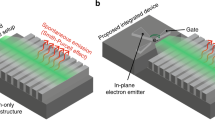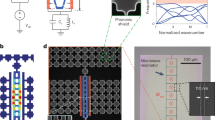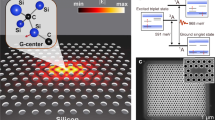Abstract
For decades, silicon has been the material of choice for mass fabrication of electronics. This is in contrast to photonics, where passive optical components in silicon have only recently been realized1,2. The slow progress within silicon optoelectronics, where electronic and optical functionalities can be integrated into monolithic components based on the versatile silicon platform, is due to the limited active optical properties of silicon3. Recently, however, a continuous-wave Raman silicon laser was demonstrated4; if an effective modulator could also be realized in silicon, data processing and transmission could potentially be performed by all-silicon electronic and optical components. Here we have discovered that a significant linear electro-optic effect is induced in silicon by breaking the crystal symmetry. The symmetry is broken by depositing a straining layer on top of a silicon waveguide, and the induced nonlinear coefficient, χ(2) ≈ 15 pm V-1, makes it possible to realize a silicon electro-optic modulator. The strain-induced linear electro-optic effect may be used to remove a bottleneck5 in modern computers by replacing the electronic bus with a much faster optical alternative.
This is a preview of subscription content, access via your institution
Access options
Subscribe to this journal
Receive 51 print issues and online access
$199.00 per year
only $3.90 per issue
Buy this article
- Purchase on Springer Link
- Instant access to full article PDF
Prices may be subject to local taxes which are calculated during checkout



 with the group index.
with the group index.

Similar content being viewed by others
References
Trinh, P. D., Yegnanarayanan, S., Coppinger, F. & Jalali, B. Silicon-on-insulator (SOI) phased-array wavelength multi/demultiplexer with extremely low-polarization sensitivity. IEEE Photon. Technol. Lett. 9, 940–942 (1997)
Pavesi, L. & Lockwood, D. J. Silicon Photonics (Springer, Berlin, 2004)
Reed, G. T. & Png, C. E. J. Silicon optical modulators. Mater. Today 8, 40–50 (2005)
Rong, H. et al. A continuous-wave Raman silicon laser. Nature 433, 725–727 (2005)
Gibbs, W. W. A split at the core. Sci. Am. 291, 96–100 (2004)
Madou, M. J. Fundamentals of Microfabrication 299–301 (CRC Press, Boca Raton, Florida, 2002)
Li, G. L. & Yu, P. K. L. Optical intensity modulators for digital and analog applications. J. Lightwave Technol. 21, 2010–2030 (2003)
Butcher, P. N. & Cotter, D. The Elements of Nonlinear Optics 5 (Cambridge Univ. Press, Cambridge, UK, 1990)
Soljacic, M. & Joannopoulos, J. D. Enhancement of nonlinear effects using photonic crystals. Nature Mater. 3, 211–219 (2004)
Notomi, M. et al. Extremely large group-velocity dispersion of line-defect waveguides in photonic crystal slabs. Phys. Rev. Lett. 87, 253902 (2001)
Joannopoulos, J. D., Villeneuve, P. R. & Fan, S. Photonic crystals: putting a new twist on light. Nature 386, 143–149 (1997)
Krauss, T. F., De La Rue, R. M. & Brand, S. Two-dimensional photonic-bandgap structures operating at near-infrared wavelengths. Nature 383, 699–702 (1996)
Joannopoulos, J. D., Meade, R. D. & Winn, J. N. Photonic Crystals: Molding the Flow of Light (Princeton Univ. Press, Princeton, 1995)
Jacobsen, R. S. et al. Direct experimental and numerical determination of extremely high group indices in photonic crystal waveguides. Opt. Express 13, 7861–7871 (2005)
Hitoshi, N. et al. Ultra-fast photonic crystal/quantum dot all-optical switch for future photonic networks. Opt. Express 12, 6606–6614 (2004)
Soref, R. A. Silicon-based optoelectronics. Proc. IEEE 81, 1687–1706 (1993)
Myers, R. A., Mukherhee, N. & Brueck, S. R. J. Large second-order nonlinearity in poled fused silica. Opt. Lett. 16, 1732–1734 (1991)
Vlasov, Y. A. & McNab, S. J. Losses in single-mode silicon-on-insulator strip waveguides and bends. Opt. Express 12, 1622–1631 (2004)
Kondo, J. et al. 40-Gb/s X-cut LiNbO3 optical modulator with two-step back-slot structure. J. Lightwave Technol. 20, 2110–2114 (2002)
Liao, W. J. et al. Proton-exchanged optical waveguides fabricated by glutaric acid. Opt. Laser Technol. 36, 603–606 (2004)
Lee, K. K., Lim, D. R., Kimerling, L. C., Shin, J. & Cerrina, F. Fabrication of ultralow-loss Si/SiO2 waveguides by roughness reduction. Opt. Lett. 26, 1888–1890 (2001)
Soref, R. A. & Bennett, B. R. Electrooptical effects in silicon. IEEE J. Quant. Electron. QE-23, 123–129 (1987)
Liu, A. et al. A high-speed silicon optical modulator based on a metal-oxide-semiconductor capacitor. Nature 427, 615–618 (2004)
Liao, L. et al. High speed silicon Mach-Zehnder modulator. Opt. Express 13, 3129–3135 (2005)
Bogaerts, W. et al. Nanophotonic waveguides in silicon-on-insulator fabricated with CMOS technology. J. Lightwave Technol. 23, 401–412 (2005)
Rasmussen, F. E. Electrical Interconnections through CMOS Wafers. PhD. thesis, Tech. Univ. Denmark (2003); http://www.mic.dtu.dk/upload/institutter/mic/forskning/mems/report-31102003.pdf
Acknowledgements
We thank R. Kjær and M. Svalgaard for their contributions. This work was supported in part by the NKT academy, the Danish Research Council for Technology and Production Sciences via the PIPE project, by NEDO via the Industrial Technology Research Area and by CINF via the Danish National Research Foundation. All generic SOI PCWs were fabricated within the framework of the European IST project PICCO and in this connection we especially thank W. Bogaerts and R. Baets.
Author information
Authors and Affiliations
Corresponding author
Ethics declarations
Competing interests
Reprints and permissions information is available at npg.nature.com/reprintsandpermissions. The authors declare no competing financial interests.
Rights and permissions
About this article
Cite this article
Jacobsen, R., Andersen, K., Borel, P. et al. Strained silicon as a new electro-optic material. Nature 441, 199–202 (2006). https://doi.org/10.1038/nature04706
Received:
Accepted:
Issue Date:
DOI: https://doi.org/10.1038/nature04706
This article is cited by
-
Integrated photonic platforms for quantum technology: a review
ISSS Journal of Micro and Smart Systems (2023)
-
Significant tensile elasticity of nanoscale boron arsenide
Science China Materials (2023)
-
Strained crystalline nanomechanical resonators with quality factors above 10 billion
Nature Physics (2022)
-
Sensitivity of quantitative symmetry measurement algorithms for convergent beam electron diffraction technique
Applied Microscopy (2021)
-
All-optical phase control in nanophotonic silicon waveguides with epsilon-near-zero nanoheaters
Scientific Reports (2021)
Comments
By submitting a comment you agree to abide by our Terms and Community Guidelines. If you find something abusive or that does not comply with our terms or guidelines please flag it as inappropriate.



